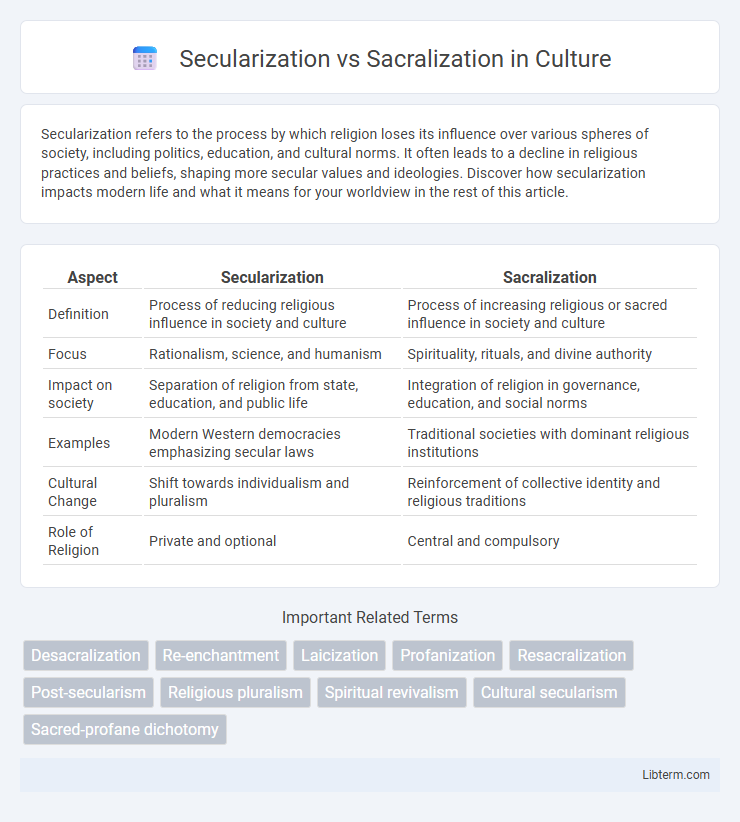Secularization refers to the process by which religion loses its influence over various spheres of society, including politics, education, and cultural norms. It often leads to a decline in religious practices and beliefs, shaping more secular values and ideologies. Discover how secularization impacts modern life and what it means for your worldview in the rest of this article.
Table of Comparison
| Aspect | Secularization | Sacralization |
|---|---|---|
| Definition | Process of reducing religious influence in society and culture | Process of increasing religious or sacred influence in society and culture |
| Focus | Rationalism, science, and humanism | Spirituality, rituals, and divine authority |
| Impact on society | Separation of religion from state, education, and public life | Integration of religion in governance, education, and social norms |
| Examples | Modern Western democracies emphasizing secular laws | Traditional societies with dominant religious institutions |
| Cultural Change | Shift towards individualism and pluralism | Reinforcement of collective identity and religious traditions |
| Role of Religion | Private and optional | Central and compulsory |
Understanding Secularization: Definitions and Perspectives
Secularization refers to the process by which religious influence diminishes in social, political, and cultural spheres, leading to the separation of religion from public life. Key perspectives include the decline thesis, which argues religion loses significance as modernization progresses, and the complexity thesis, which suggests secularization varies across contexts and dimensions. Understanding secularization requires analyzing its impact on beliefs, institutions, and individual behaviors within increasingly pluralistic societies.
The Concept of Sacralization: A Brief Overview
Sacralization refers to the process by which people attribute sacred qualities or divine significance to objects, places, or social practices, distinguishing them from the ordinary or profane. This concept highlights the transformation of everyday elements into symbols of spiritual or religious importance, often reinforcing community identity and cultural cohesion. Sacralization plays a crucial role in shaping rituals, myths, and social norms by imbuing them with transcendent meaning.
Historical Contexts: Secularization Through the Ages
Secularization historically emerged during the Enlightenment as scientific reasoning and individualism challenged ecclesiastical authority, reshaping societal structures and governance. The gradual decline of religious influence in public institutions, law, and education marked a transition from sacralized worldviews to secular frameworks, particularly in Western Europe from the 17th to 19th centuries. This transformation continued into modernity with industrialization and globalization promoting pluralism and the separation of church and state across diverse cultures.
Sacralization in Modern Societies: Trends and Patterns
Sacralization in modern societies manifests through the resurgence of spiritual practices, the integration of religious symbolism in public spaces, and the rise of new religious movements adapting to contemporary values. These trends reflect a complex interplay between tradition and innovation, where secular institutions sometimes incorporate sacred elements to address cultural identity and social cohesion. Patterns indicate increasing personalization of faith, blending of diverse religious beliefs, and the use of technology to promote and organize spiritual communities.
Drivers of Secularization: Causes and Consequences
Industrialization, urbanization, and scientific advancements serve as primary drivers of secularization, promoting rationalism and diminishing traditional religious authority. The decline in religious influence often leads to changes in social values, increased individualism, and shifts in institutional power dynamics. Consequences include the rise of secular governance, reduced religious participation, and a redefinition of moral frameworks within society.
The Role of Culture in Sacralization Processes
Culture functions as a foundational framework in sacralization processes by embedding symbols, rituals, and collective memories that transform ordinary elements into sacred entities, reinforcing social cohesion and identity. Through cultural narratives and practices, communities sacralize spaces, objects, and behaviors, imbuing them with profound spiritual or moral significance beyond their mundane functions. This dynamic interplay between culture and sacrality reveals how symbolic meanings are continuously constructed and negotiated, shaping religious experiences and societal values.
Secularization vs Sacralization: Comparative Analysis
Secularization refers to the diminishing influence of religion and sacred values in societal institutions and individual lives, marked by increased reliance on scientific rationality and secular governance. Sacralization, conversely, involves the process of attributing sacred meaning and religious significance to everyday practices, places, or social phenomena, reinforcing spiritual authority and identity. Comparative analysis reveals that secularization often aligns with modernization and pluralism, whereas sacralization emerges as a response to cultural shifts, promoting cohesion and resistance to secular trends.
Case Studies: Examples from Different Religions and Regions
Secularization and sacralization processes manifest distinctly across various religions and regions, exemplified by Turkey's transition from Ottoman Islamic traditions to a secular republic, contrasted with India's persistent sacralization through Hindu nationalism reinforcing religious identity in politics. In Western Europe, secularization led to declining church influence on societal norms, while in Latin America, movements like Liberation Theology illustrate a sacralization blending Christian doctrine with social justice activism. These case studies highlight complex dynamics where cultural, political, and religious factors interplay, shaping regional expressions of secular and sacred life.
Social Impacts: How Secularization and Sacralization Shape Communities
Secularization reduces the influence of religious institutions in public life, often leading to more pluralistic and diverse communities where social norms are shaped by secular values and individual rights. Sacralization reinforces communal bonds through shared sacred beliefs and rituals, fostering social cohesion and collective identity rooted in religious traditions. The balance between secularization and sacralization impacts social structures, influencing policy-making, community engagement, and conflict resolution within societies.
Future Outlook: The Evolving Balance Between Secular and Sacred
The future outlook on secularization versus sacralization reveals a dynamic interplay where technological advancements and globalization amplify secular perspectives, while cultural revivals and spiritual movements foster renewed sacralization. Urbanization trends and digital connectivity contribute to reshaping communal identities, blending traditional sacred values with modern secular practices. Predictive models suggest increasing pluralism with localized sacralization efforts coexisting alongside expansive secular frameworks in governance, education, and social discourse.
Secularization Infographic

 libterm.com
libterm.com